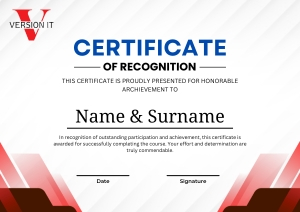Home > Courses > Full Stack Courses > Dot Net Full Stack > Oracle Course
Oracle Training in
Hyderabad
Oracle Training in Hyderabad is the process of blending Oracle database with MS’s .Net Framework in order to give developers room for constructing advanced software with high capacity expansion.
26 Modules
with Certifications
Certificate
After Completion
English
Language
Developers can take advantage of Oracle’s database power in the well-known .NET environment, enabling efficient data manipulation and high-performing applications.
With the use of Oracle in .Net, there are varied benefits such as easy connection to Oracle Database for fast access to data, optimization of data accessing and manipulation, and added security measures. ODP.NET is compatible with ADO.NET, thus enabling developers to interact easily with databases. Furthermore, the partnership creates a strong base for scaling out and solid applications on .NET which have extensive usage of Oracle’s sophisticated components.
One will, therefore, realize that choosing an Oracle Course in a VersionIt Training Institute is rewarding. Specialized teachers help one to understand the detailed information of version control software such as Git that enhances teamwork in coding. Ultimately, it is Better for career advancement and growth.
Oracle Course Objectives:
The objectives encompass providing participants with a comprehensive understanding of The application of Oracle in .Net also brings diverse gains including easy linking with the Oracle database for quick information retrieval, data access and modifications enhancement, and improved safety precautions. Therefore, ODP.NET is integrated with ADO.NET which helps the developer to communicate with the database easily. Moreover, this union forms a solid footing for broadening applications in Microsoft’s powerful .NET framework that depend heavily on Oracle’s intricate modules.
To sum it up Oracle courses in .NET is to provide individuals with the capacity of incorporating Oracle databases within .NET programs for proper maintenance and exchange of information between these systems.
Topics You will Learn
Introduction to DBMS
- Approach to Data Management
- Introduction to prerequisites
- File and Filesystem
- Disadvantages of file
- Review of Database Management Terminology
- Database Models
- Hierarchal Model
- Network Model
- Relational Model
Introduction to RDBMS
- Feature of RDBMS
- Advantages of RDBMS over FMS ad DBMS
- The 12 rules (E.F Codd’s Rules –RDBMS)
- Need for Database Design
- Support of Normalization Process for Data Management
- Client-Server Technology
- Oracle Corporation Products
- Oracle Versions
- About SQL&SQL*PLUS
Introduction to SQL Database Object
- Oracle Pre Defined Datatypes
- DDL Commands
- Create, Alter (add, modify, rename, drop)Columns, Rename, truncate, drop
- DML-Insert, update, delete
- DQL-SELECT Statements using WHEREclause
- Comparison and Conditional Operators
- Arithmetic and Logical Operators
- Set Operators (UNION, UNION ALL, INTERSECT, MINUS)
- Special Operators – IN (NOT IN), BETWEEN (NOT BETWEEN), LIKE (NOT LIKE), IS NULL (IS NOT NULL)
- Working with DML, DRL Commands
- Operators Support
Sub Language Commands
- Data Definition Language (DDL)
- Data Retrieval Language (DRL)
- Data Manipulation Language (DML)
- Transaction Control Language (TCL)
- Database Security and Privileges (DCL)
Built-in Functions
- Arithmetic Functions, Character Functions, Date Functions, Conversion Functions
- Aggregate Functions, OLAP Functions & General Functions
Grouping the Result of a Query
- Using Group by and Having Clause of DRL Statement
- Using Order by clause
Working with Integrity Constraints
- Importance of Data Integrity
- Support of Integrity Constraints for Relating Table in RDBMS
- NOT NULL constraint
- UNIQUE constraint
- PRIMARY KEY constraint
- FOREIGN KEY constraint
- CHECK constraint
- Working with different types of Integrity Constraints
REF constraint
- Understanding ON DELETE clause in referential integrity constraint
- Working with a composite constraint
- Applying DEFAULT option to columns
- Working with multiple constraints upon a column
- Adding constraints to a table
- Dropping of constraints
- Enabling / Disable constraints
- Querying for constraints information
Querying Multiple Tables (Joins)
- Equi Join/Inner Join/Simple Join
- Cartesian Join
- Non-Equi Join
- Outer Joins
- Self Join
Working with Sub Queries
- Understanding the practical approach to Sub Queries/Nested Select/Sub Select/Inner Select/Outer Select
- What is the purpose of a Sub Query?
- Sub Query Principle and Usage
- Type of Sub Queries
- Single Row
- Multiple Row
- Multiple Column
- Applying Group Functions in Sub Queries
- The impact of Having Clause in Sub Queries
- IN, ANY/SOME, ALL Operators in Sub Queries
- PAIRWISE and NON PAIRWISE Comparison in Sub Queries
- Be … Aware of NULL’s
- Correlated Sub Queries
- Handling Data Retrieval with EXISTS and NOT EXISTS Operators
Working with DCL, TCL Commands
- Grant, Revoke
- Commit, Rollback, Savepoint
- SQL Editor Commands
- SQL Environment settings
Maintaining Database Objects VIEWS in Oracle
- Understanding the Standards of VIEWS in Oracle
- Types of VIEWS
- Relational Views
- Object Views
- Prerequisites to work with views
- Practical approach of SIMPLE VIEWS and COMPLEX VIEWS
- Column definitions in VIEWS
- Using VIEWS for DML Operations
- In-Line View
- Forced Views
- Putting CHECK Constraint upon VIEWS
- Creation of READ ONLY VIEWS
- Understanding the IN LINE VIEWS
- About Materialized Views
View Triggers
- Working with Sequences
- Working with Synonyms
- Working with Index and Clusters
- Creating Cluster Tables, Implementing Locks, working with roles
Pseudo Columns in Oracle
- Understanding Pseudo Columns in Oracle
- Types of Pseudo Columns in Oracle
- CURRVAL and NEXTVAL
- LEVEL
- ROWID
- ROWNUM
Data Partitions and Parallel Process
- Types of Partitions
- Range Partitions
- Hash Partitions
- List Partition
- Composite Partition
- Parallel Query Process
Locks
- Row level Locks
- Table Level Locks
- Shared Lock
- Exclusive Lock
- Dead Lock
SQL * Loader
- SQL * Loader Architecture
- Data file (Input Datafiles)
- Control file
- Bad file
- Discard file
- Log file
- .txt to base table
- .csv to base table
- From more than one file to single table
PL-SQL (Procedure Language – SQL)
- Introduction to Programming Languages
- Introduction to PL/SQL
- The Advantages of PL/SQL
- PL/SQL Architecture
- PL/SQL Datatypes
- Variable and Constants
- Using Built_in Functions
- Conditional and Unconditional Statements
- Simple if, if… else, nested if..else, if..else Ladder
- Selection Case, Simple Case, GOTO Label and EXIT
- Iterations in PL/SQL
- Simple LOOP, WHILE LOOP, FOR LOOP and NESTED LOOPS
- SQL within PL/SQL
- Composite Data types (Complete)
- Cursor Management in PL/SQL
- Implicit Cursors
- Explicit Cursors
- Cursor Attributes
- Cursor with Parameters
- Cursors with LOOPs Nested Cursors
- Cursors with Sub Queries
- Cursors
- Record and PL/SQL Table Types
Advanced PL/SQL
- Procedures in PL/SQL
- STORED PROCEDURES
- PROCEDURE with Parameters (IN,OUT and IN OUT)
- POSITIONAL Notation and NAMED Notation
- Procedure with Cursors
- Dropping a Procedure
- Functions in PL/SQL
- Difference between Procedures and Functions
- User Defined Functions
- Nested Functions
- Using stored function in SQL statements
- Packages in PL/SQL
- Creating PACKAGE Specification and PACKAGE Body
- Private and Public Objects in PACKAGE
EXCEPTIONS in PL/SQL
Types of exceptions
- User-Defined Exceptions
- Pre Defined Exceptions
- RAISE_APPLICATION_ERROR
- PRAGMA_AUTONOMOUS_TRANSACTION
- SQL Error Code Values
Database Triggers in PL/SQL
- Types of Triggers
- Row Level Triggers
- Statement Level Triggers
- DDL Triggers
- Trigger Auditing
File Input/Output
- PL/SQL file I/O (Input/Output)
- Using UTL_FILE Package
Implementing Object Technology
- What is Object Technology ?
- OOPS-Object Instances
- Creation of objects
- Creating User-Defined Data Types
- Creating Object Tables
- Inserting rows in a table using Objects
- Retrieving data from Object-based Tables
- Calling a Method
- Indexing Abstract Data type Attributes
Using LOBS
- Large Objects (LOBS)
- Creating Tables-LOB
- Working with LOB values
- Inserting, Updating & Deleting Values in LOBs
- Populating Lobis DBMS_LOB Routines
- Using B-FILE
Using Collections
- Advantages of collection
- Ref cursor (Dynamic Cursor)
- Weak ref cursor
- Strong ref cursor
- Nested Tables VARRAYS or VARYING arrays
- Creating tables using nested tables
- Inserting, updating & deleting Nested
- Table records
- Nested table in PL/SQL
Oracle Database Architecture
- Introduction to Oracle Database Architecture
- Physical structures Logical structures
- DB Memory Structures Background Process
- 2 Tire, 3 Tire, N-Tier Architecture
Advanced Features
- 9i Joines
- New Date function
- Rename column
- Inner Join/Natural Join
- Left Outer Join/Right Outer Join
- Full Outer Join
- Multiple Inserts
- Insert All Command
- Merge statement
- NVL2(), NULLIF(), COALESCE()
- CASE expression of Select Command
- Temporary Tables/Global Tables
- New Function EXTRACT()
- Autonomous Traction
- Pragma _ Autonomous_ Transaction()
- Bulk Collect
- About Flash Back Queries
- Dynamic SQL
- New data types, Flash back Command
- Purge Command, Recyclebin
- Regular expressions, DML Error Logging
- Data Pump, Virtual Columns
- Read only tables, Cross tab Views using
- Pivot/Unpivot operators, Follows Clause
- Compound triggers, New data types
DBA CONCEPTS
- Database
- Tablespace
- Types of Tablespaces
- Data files /Se
Let Your Certificates Speak

- Oracle Power Unlocked: Certified and Excel-Ready
- Certifications improve your programming profile and are accepted across the world.
- Certificates are issued upon the course's conclusion.
All You Need to Start this Course
- The Programming Language C#
- Framework for.NET
- Visual Studio
- Database and SQL Concepts
Testimonials




Still Having Doubts?
Oracle.NET is the name given to the integration of the Oracle Database with the Microsoft.NET platform. It makes it possible for programmers to write.NET applications that interface with Oracle databases.
While not always necessary, having a basic knowledge of Oracle Database concepts is helpful. A basic understanding of connecting to and using an Oracle database might be helpful.
While it's recommended to have a basic understanding of programming concepts, certain courses may be designed with complete novices in mind. It's important to read the prerequisites and course description to determine the required level of experience.
After completing an Oracle.NET course, opportunities for work as a database developer, software engineer, or.NET developer with a focus on integrating.NET applications with Oracle databases may become accessible.


